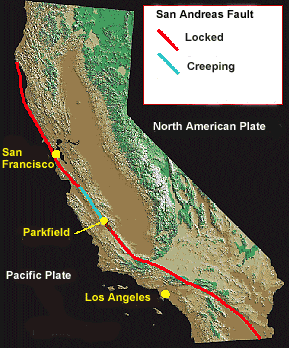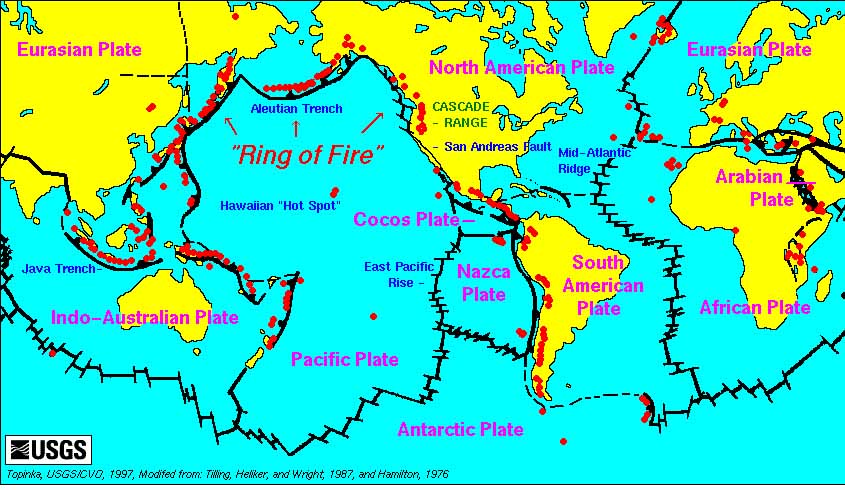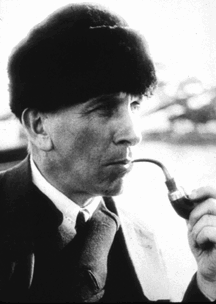 The movement of the plates is typically one centimeter per year. Surprising? An example of plate tectonics is convergent and divergent boundaries. These are two BIG phenomenon's that happen when the boundaries collide and move apart. A result from plate movement can be Volcanic eruptions, earthquakes, the formation of mountains, ect. You can see a volcanic eruption in our video bar.
The movement of the plates is typically one centimeter per year. Surprising? An example of plate tectonics is convergent and divergent boundaries. These are two BIG phenomenon's that happen when the boundaries collide and move apart. A result from plate movement can be Volcanic eruptions, earthquakes, the formation of mountains, ect. You can see a volcanic eruption in our video bar.
Tuesday, April 14, 2009
Plate Tectonics
PLATE TECTONICS is a MIGHTY event. This is a term used in geology when parts of the earth's crust, or plates, move apart or closer together. This is caused by HUGE, MASSIVE convection currents. These convection currents drive the plates, and they move away from each other at the rate that fingernails GROW.  The movement of the plates is typically one centimeter per year. Surprising? An example of plate tectonics is convergent and divergent boundaries. These are two BIG phenomenon's that happen when the boundaries collide and move apart. A result from plate movement can be Volcanic eruptions, earthquakes, the formation of mountains, ect. You can see a volcanic eruption in our video bar.
The movement of the plates is typically one centimeter per year. Surprising? An example of plate tectonics is convergent and divergent boundaries. These are two BIG phenomenon's that happen when the boundaries collide and move apart. A result from plate movement can be Volcanic eruptions, earthquakes, the formation of mountains, ect. You can see a volcanic eruption in our video bar.
 The movement of the plates is typically one centimeter per year. Surprising? An example of plate tectonics is convergent and divergent boundaries. These are two BIG phenomenon's that happen when the boundaries collide and move apart. A result from plate movement can be Volcanic eruptions, earthquakes, the formation of mountains, ect. You can see a volcanic eruption in our video bar.
The movement of the plates is typically one centimeter per year. Surprising? An example of plate tectonics is convergent and divergent boundaries. These are two BIG phenomenon's that happen when the boundaries collide and move apart. A result from plate movement can be Volcanic eruptions, earthquakes, the formation of mountains, ect. You can see a volcanic eruption in our video bar.
Thursday, April 9, 2009
California's Main Geological Features
California's main geological features vary due to location. For example, the pictures you see under all the text are maps of the San Andrea's fault line. For many years, residents near the bay have been worried that a massive earthquake, called "The Big One," will strike, and the San Andrea's fault line will split open (Just one or two inches), but the areas near and around the fault line will be devastated, like San Francisco. Also, California has many volcanoes. The volcanos include Amboy Crater, Black Butte, Clear Lake, Coso Volcanic Field, Glass Mountain, Golden Trout Creek Volcanic Field, Gorda Ridge, Inyo Craters, Inyo Domes, Lassen Peak, Lasen Volcanic National Park, Lava Beds Vicinity, Lava Beds National Monument, Long Valley Caldrea, Mammoth Mountain, Medicine Lake, Mono Craters, Mono Domes, Mount Konocti, Mount Lassen, , Mount Shasta Salton Buttes, and Sutton Buttes. Some of these are active, though most are not.We shall now look into one particular volcano, Mt. Shasta. Mt. Shasta is a stratovolcano, or a volcano that is formed by subduction. It is made up of many layers of ash and molten rock.




Wednesday, April 8, 2009
The Layers of the Earth
The Layers of the Earth are the deepest depths, the very bowels of the earth are so deep that mankind cannot travel into the center of the Earth. The crust is 40 kilos (Kilometers). The upper mantle is 40 to 400 kilos. The transition region is 400 to 650 kilos. The lower mantle is 650 to 2700 kilos. The "D" layer is 2700 to 2890 kilos. The outer core is 2890 to 5150 kilos deep. And finally, the inner core is 5150 to 6378 kilos deep. In all, this totals roughly 18,208 kilometers deep. It is about 7 layers deep, although it is 6 regions in all. The crust is the top layer that we live on, and all living things would survive on the crust. The mantle is right beneath this, which is composed of molten magma. This is the second to biggest region of the Earth, and is very hot. Volcanoes form from cracks in the crust, and once in a while, a live, active volcanoes blow their top. After the mantle, the core of the earth is made out of molten iron. This is the biggest region of the Earth. The molten iron produces earth's magnetic field. The temperatures were so hot, that the iron remains in a liquid state!

Tuesday, April 7, 2009
Mid-Ocean Ridges of the Ocean
Mid-Ocean Ridges are underwater mountain ranges in the world's oceans. They have a valley called a rift running down its spine. They are caused by sea-floor spreading which is the process of the sea-floor spreading letting the magma seep through the crack and creating new land. The mid-ocean ridge system is the longest mountain range in the world. Lava is brought up to the ocean, and more lava is created, push the plates a little more. These mountains trace where the Earth's plates moved apart from each other.
The Ring of Fire
The Ring of Fire is an arc made of volcanoes. It has 75% of Earth's dormant volcanoes.Did you know that Mt. Saint Helens is in the Ring of Fire? Mt. Saint Helens erupted very recently. It wasn't like oozing lava but it was a huge explosion that killed plants and animals in the blast radius. Earthquakes often happen there, and it is shaped like a horseshoe. Some volcanoes have cultural or religious significances on people living near or around the volcanoes themselves. 

Divergent and Convergent Boundaries
Divergent and Convergent Boundaries are boundaries that diverge or converge. A divergent boundary is two tectonic plate moving away from each other, or diverging. Convergent boundaries are two or more lithospheric plate moving toward each other and colliding head-on. In a subduction zone, a plate collides with another plate and one plate gets squeezed into the mantle. This is a process called subduction. Sometimes, the two colliding plate may create mountain ranges, like a mid-ocean ridge, or an underwater mountain range. They can also create volcanoes.
Pangaea- The SUPER-continent
Pangaea was a super-continent created around 250 million years ago in the Permian period. When this broke apart, it became our modern continents. This is due to continental drift, a theory proposed by Alfred Wegener publicly in 1912 that the continents once were connected, therefore they have too move around the face of the Earth. This was somewhat correct, but is not the generally accepted. The evidence is the fossil finds on two different continents, and fossilized plants on two different continents. This could only be possible if these continents were connected. 

Subscribe to:
Posts (Atom)
